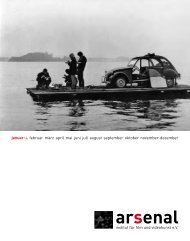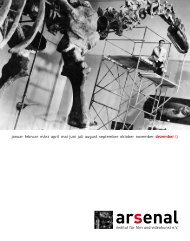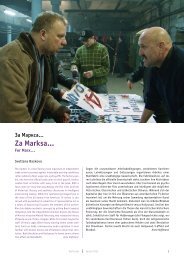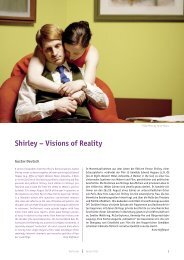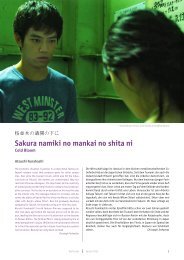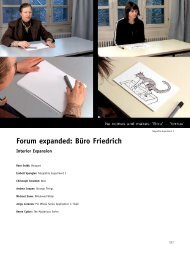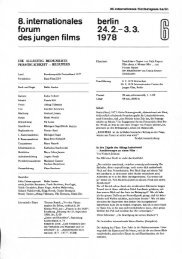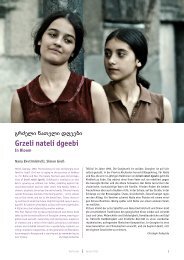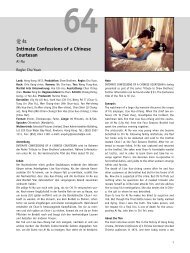Forum expanded: Back and Forth – Cinema Talks - Arsenal
Forum expanded: Back and Forth – Cinema Talks - Arsenal
Forum expanded: Back and Forth – Cinema Talks - Arsenal
Create successful ePaper yourself
Turn your PDF publications into a flip-book with our unique Google optimized e-Paper software.
<strong>Forum</strong> <strong>exp<strong>and</strong>ed</strong>: <strong>Back</strong> <strong>and</strong> <strong>Forth</strong> <strong>–</strong> <strong>Cinema</strong> <strong>Talks</strong><br />
Experimentations from India <strong>–</strong> <strong>Cinema</strong> Talk with Shai Heredia <strong>and</strong> Nicole Wolf<br />
The Miss Chief Eagle Testickle Trilogy <strong>–</strong> <strong>Cinema</strong> Talk with Kent Monkman, Gisèle Gordon<br />
Letters <strong>–</strong> <strong>Cinema</strong> Talk with Graham Weinbren<br />
Marie Losier Goes Underground <strong>–</strong> <strong>Cinema</strong> Talk with Marie Losier<br />
<strong>Cinema</strong>nilacs <strong>–</strong> <strong>Cinema</strong> Talk with Khavn De La Cruz, Kidlat Tahimik, John Torres<br />
Jack Smith, Part 2 <strong>–</strong> <strong>Cinema</strong> Talk with Jerry Tartaglia<br />
The Basis of Make-Up <strong>–</strong> <strong>Cinema</strong> Talk with Heinz Emigholz
Experimentations from India<br />
<strong>Cinema</strong> Talk with Shai Heredia <strong>and</strong> Nicole Wolf<br />
What are possible cinematic entry points to address histories<br />
of experimental filmmaking in the context of India? This film<br />
program curated by Shai Heredia showcases selected film <strong>and</strong><br />
video examples from which a discussion on diverse forms of<br />
experimentation can be discussed. Their historical, political, institutional<br />
<strong>and</strong> film aesthetical references open out a series of<br />
questions on film formats that oscillate between the contextual<br />
<strong>and</strong> trans-national. More information: www.filterindia.com<br />
And I Make Short Films<br />
S.N.S. Sastry, India 968, B&W, sound, 35mm, 6 minutes<br />
The film explores the process, ideas <strong>and</strong> context of documentary<br />
filmmaking in India at the time <strong>–</strong> art or documentation of reality.<br />
Trip<br />
Pramod Pati, India 970, B&W, sound, 35mm, 4 minutes<br />
A film about Bombay that uses pixilation to depict the transitoriness<br />
of daily life in an urban context.<br />
Antara<br />
Ashish Avikunthak, India 2006, color, sound, 6mm, 8 min.<br />
Three women reminisce about their times at school <strong>and</strong> rekindle<br />
<strong>and</strong> affirm old friendships. The film is a cinematic interpretation<br />
of Samuel Beckett’s 967 dramaticule Come <strong>and</strong> Go.<br />
Kshya tra gya / xyz<br />
Amit Dutta, India 2004, color, sound, 35mm, 22 minutes<br />
A boy (who is also an old man) tries to tell a story. With a<br />
rhythmic structure, this abstract narrative tale is told using incamera<br />
special effects <strong>and</strong> mythological references to Indian<br />
narrative traditions.<br />
Bare<br />
Santana Issar, India 2006, color, sound, DV, minutes<br />
By piecing together home videos shot by her parents nearly two<br />
decades earlier, <strong>and</strong> through a string of conversations with family<br />
members, a daughter looks to underst<strong>and</strong> the impact of her<br />
father’s alcoholism on their lives.<br />
About Elsewhere<br />
Priya Sen, India 2007, color, sound, DV, 29 minutes<br />
ABOUT ELSEWHERE is a film that seeks to highlight the impossibility<br />
of fixing notions of sexuality through ideas of “identity”<br />
<strong>and</strong> “language.” As the film moves through various worlds the<br />
filmmaker has inhabited, it suggests a self in constant formation;<br />
one that constructs itself from parts <strong>and</strong> places that are in<br />
themselves, fragments of memory <strong>and</strong> experience.<br />
Shai Heredia is the director of Experimenta, the international<br />
festival for experimental cinema in India <strong>and</strong> she works for the<br />
India Foundation for the Arts <strong>–</strong> India’s only arts philanthropic<br />
organization <strong>–</strong> to make arts grants under the Extending Arts<br />
Practice program.<br />
2<br />
Nicole Wolf is currently working on her book Make it Real. Documentary<br />
<strong>and</strong> Other <strong>Cinema</strong>tic Experiments by Women Filmmakers<br />
in India. She teaches at the Visual Cultures Department at Goldsmiths,<br />
University of London.<br />
The Miss Chief Eagle Testickle Trilogy<br />
<strong>Cinema</strong> Talk with Kent Monkman, Gisèle Gordon<br />
The three Canadian films of the trilogy refer to the history of<br />
adventure <strong>and</strong> western film, as well as to construction of identities<br />
in cinema <strong>and</strong> art production. GROUP OF SEVEN INCHES was<br />
shown in the Panorama section of the Berlin International Film<br />
Festival in 2006; SHOOTING GERONIMO is participating in the<br />
Berlinale Shorts competition in 2008.<br />
The trilogy features the adventures <strong>and</strong> histories of Miss Chief<br />
Eagle Testickle, the outrageous alter ego of Cree artist Kent<br />
Monkman. Turning dismissive writings on the “romantic savage“<br />
upside down, she seduces innocent white men with whiskey <strong>and</strong><br />
dresses them up as more “authentic” examples of the ”European<br />
male” (GROUP OF SEVEN INCHES), then intercedes in a film shoot<br />
by famed romantic filmmaker Frederick Curtis, who plays on the<br />
jealousy between his sexy young Cree actors, whereby teasing the<br />
action into a tragic twist (SHOOTING GERONIMO). Finally, Miss<br />
Chief Eagle Testickle journeys far across the seas to study the<br />
unspoiled European Male in his native habitat (ROBIN’S HOOD)<br />
Group of Seven Inches<br />
Kent Monkman, Gisèle Gordon, 2005, color, sound, DV, 7:35 min.<br />
Shooting Geronimo<br />
Kent Monkman, 2007, color, sound, DV, : min.<br />
Robin‘s Hood<br />
Kent Monkman, Gisèle Gordon, 2007, color, sound, DV, 5:53 min.<br />
Kent Monkman is an artist of Cree ancestry who works with<br />
a variety of media, including painting, film/video, performance<br />
<strong>and</strong> installation. His recent work facilitates dialogue about colonial<br />
power relations using sexuality as a forum to negotiate<br />
power. He has participated in group <strong>and</strong> solo exhibitions worldwide.<br />
His award-winning short film <strong>and</strong> video works have been<br />
screened at various national <strong>and</strong> international festivals. His<br />
work is represented in the collections at the National Gallery<br />
of Canada, Montreal Museum of Fine Art, Museum London, the<br />
Woodl<strong>and</strong> Cultural Centre, the Indian Art Centre, The Mackenzie<br />
Art Gallery, <strong>and</strong> the Canada Council Art Bank.<br />
Gisèle Gordon is a filmmaker, story editor <strong>and</strong> programmer. She<br />
directed the feature-length documentary The Tunguska Project.<br />
Gordon curated a program of Canadian films for the Salekhard<br />
Northern Nomadic Film Festival in Russia <strong>and</strong> serves on the board<br />
of directors of the imagineNATIVE Film + Media Arts Festival <strong>and</strong><br />
the Images Festival in Toronto.<br />
Production Company Urban Nation is a partnership between<br />
Gisèle Gordon <strong>and</strong> Kent Monkman.<br />
More information: www.urbannation.com
Letters<br />
<strong>Cinema</strong> Talk with Graham Weinbren<br />
Letters<br />
Graham Weinbren, GB 2008, LimoHD<br />
Interactive cinema installation, color, sound, 45 minutes<br />
Zorn‘s Lemma<br />
Hollis Frampton, USA 970, 6mm, color, sound, 60 minutes<br />
LETTERS is an exp<strong>and</strong>ing database of film essays. Each is exactly<br />
one minute long <strong>and</strong> generates (in the broadest sense) a letter<br />
of the alphabet. LETTERS encompasses a range of themes <strong>and</strong><br />
obsessions ranging from the everyday to the sublime, including<br />
growth, decay, copulation, childhood, the strange language<br />
of President Bush, food, the philosophy of Wittgenstein, the<br />
animalness of animals, military drill in the age of the Internet,<br />
shaving. Also included in this screening are the short films Turner<br />
on the Tyne (2006), a non-verbal study of a Turner painting,<br />
<strong>and</strong> the LimoHD premiere of the classic Bertha’s Children, made<br />
in collaboration with Roberta Friedman in 978, <strong>and</strong> interviews<br />
between the artist <strong>and</strong> a journalist (both played by Weinbren),<br />
referring to the structural film classic ZORN’S LEMMA by Hollis<br />
Frampton based on transformations of alphabetic sets, inspired<br />
by the mathematical theorem named after Max Zorn.<br />
Grahame Weinbren has been making films, videos <strong>and</strong> media art<br />
works since the 970s. He is a pioneer of interactive cinema,<br />
<strong>and</strong> often develops new tools <strong>and</strong> technologies for his work. His<br />
most recent projects are shown in LimoHD, a high resolution<br />
moving image playback system developed in collaboration with<br />
engineer Isaac Dimitrovsky. Weinbren edits the Millennium Film<br />
Journal <strong>and</strong> is on the graduate faculty of the School of Visual<br />
Arts in New York.<br />
Marie Losier Goes Underground<br />
<strong>Cinema</strong> Talk with Marie Losier<br />
Marie Losier journeys to Wonderl<strong>and</strong> as a portrait painter <strong>and</strong><br />
star photographer, filming protagonists of the underground who<br />
enchanted her, like Richard Foreman, Mike <strong>and</strong> George Kuchar,<br />
Guy Maddin, <strong>and</strong> Tony Conrad. Just as she once entered into<br />
Dreyer’s film as Jeanne d’Arc, here she vanishes completely in<br />
the underworlds of film history. She develops her own cinematic<br />
language from her symbiosis with the model.<br />
<strong>Back</strong> to Nature, George Kuchar, USA 976, 0 minutes<br />
It’s a love story of betrayal, a search for happiness, fulfillment<br />
<strong>and</strong> misery among nature’s gr<strong>and</strong>eur.<br />
Bird, Bath <strong>and</strong> Beyond<br />
Marie Losier, USA 2004, 3 minutes<br />
In this dream-portrait of Mike Kuchar, he floats through his<br />
memories as the sea, space <strong>and</strong> sky drift past.<br />
Electrocute Your Stars<br />
Marie Losier, USA 2005, 8 minutes<br />
This is a dream-portrait of George Kuchar, travelling through<br />
snow confetti, strobe flashes <strong>and</strong> artificial wind as he describes<br />
his weather diaries.<br />
Snow Beard<br />
Marie Losier, USA 2007, 3 minutes<br />
“We were on a roof in Queens on a cold winter’s day until Mike<br />
Kuchar’s beard turned into a snow sculpture.“ (M.L.)<br />
Straight <strong>and</strong> Narrow<br />
Tony <strong>and</strong> Beverly Conrad, USA 970, 0 minutes<br />
STRAIGHT AND NARROW is a study in subjective color <strong>and</strong> visual<br />
rhythm.<br />
Tony Conrad DreaMinimalist<br />
Marie Losier, USA 2008, 26 minutes<br />
This is a dream portrait of Tony Conrad, the experimental filmmaker,<br />
musician/composer, sound artist, teacher <strong>and</strong> writer.<br />
Violinist Tony Conrad was one of the pioneers of New York minimalism.<br />
Marie Losier is a filmmaker <strong>and</strong> curator working in New York<br />
City. She has shown her films <strong>and</strong> videos at museums, galleries,<br />
biennials <strong>and</strong> festivals. She was included in the 2006 Whitney<br />
Biennial (Whitney Museum, NY) with her film on Richard Foreman,<br />
The Ontological Cowboy.<br />
<strong>Cinema</strong>nilacs<br />
<strong>Cinema</strong> Talk with John Torres, Khavn De La Cruz, Christoph<br />
Janetzko<br />
In 989, the <strong>Forum</strong> showed short experimental films shot in<br />
the Philippines in a workshop led by Berlin filmmaker Christoph<br />
Janetzko. Uwe Schmelter of the Goethe Institute saw unusually<br />
creative powers in this country’s independent film scene <strong>and</strong><br />
initiated the project. These films are still part of the collection<br />
of the Friends of the German <strong>Cinema</strong>thèque (arsenal experimental).<br />
John Torres <strong>and</strong> Khavn De La Cruz st<strong>and</strong> for younger<br />
generations of filmmakers with an extremely individualistic film<br />
language, always in the context of an artistic practice strongly<br />
molded by music. In the <strong>Forum</strong> or <strong>Forum</strong> <strong>exp<strong>and</strong>ed</strong>, both show<br />
new productions with live music. Roxlee, one of the filmmakers<br />
from 989, produced the music in one of Khavn’s most recent<br />
films <strong>–</strong> just one of the connections between then <strong>and</strong> now. With<br />
John Torres, Khavn De La Cruz, Kidlat Tahimik (the director of<br />
Perfumed Nightmare) <strong>and</strong> in the presence of Christoph Janetzko,<br />
we take another look at <strong>and</strong> discuss the earlier films.<br />
Oldeastside<br />
Khavn De La Cruz, Philippines 2006, video, 6 minutes<br />
Very short, non-malignant parody of the ultra-long films by Lav<br />
Diaz in general <strong>and</strong> Batang West Side in particular.<br />
3
Kidlat<br />
Joey Agbayani, Robby Agbayani, Philippines 988, 6mm, 0<br />
minutes<br />
An experimental film about a journalist who goes up against a<br />
traditional crooked politician (“trapo”) <strong>and</strong> his private army.<br />
Magkakahoy<br />
Noel Lim, Teddy Co, Philippines 988, 6mm, 0 minutes<br />
Story of a woodcutter, monstrous buildings <strong>and</strong> evil vehicles.<br />
Spit, Optik<br />
Roxlee, Philippines 988, 6mm, 5 minutes<br />
Dizzying visions of Manila overlaid with translucent layers suggesting<br />
origin myths, sexual psychosis, post-colonial anxiety<br />
<strong>and</strong> more.<br />
Delirious<br />
Melchior L. Bacani III, Deo F. Noveno, Philippines 988, 6mm,<br />
8 minutes<br />
A visualization of a mental disturbance.<br />
Sa Maynila<br />
Mike Alcazaren, Jo Atienza, Vic Bacani, Ricky Orellana, Allan<br />
Hilario, Philippines 988, 6mm, 7 minutes<br />
With a nod to Man with a Movie Camera, a quick look at the<br />
working h<strong>and</strong>s of Metro Manila.<br />
Biographies: John Torres, Khavn De La Cruz<br />
See YEARS WHEN I WAS A CHILD OUTSIDE (FAMILY MULTI SCREEN)<br />
<strong>and</strong> THE MUZZLED HORSE<br />
Jack Smith, Part 2<br />
<strong>Cinema</strong> Talk with Jerry Tartaglia<br />
Filmmaker <strong>and</strong> archivist Jerry Tartaglia was a guest once before,<br />
in the series curated by Marc Siegel, “Underground/Overseas”<br />
(<strong>Forum</strong> <strong>exp<strong>and</strong>ed</strong> 2007). Now Tartaglia presents previously unavailable<br />
6mm <strong>and</strong> Super8 films by the performer, filmmaker,<br />
<strong>and</strong> photographer Jack Smith, one of the most important American<br />
underground artists of the 960s. Tartaglia also presents<br />
more previously unseen material this year.<br />
Sindbad of Bagdad<br />
Jack Smith, USA 978<br />
Super 8 transfered to DVD, 29 minutes<br />
These edited-in-camera reels document a film performance by<br />
Jack Smith that was shot in the 970s on the Sahara at Coney<br />
Isl<strong>and</strong> in NYC. The audio track is assembled from Jack‘s record<br />
collection with digital transfer by Sean Kirk <strong>and</strong> Jerry Tartaglia.<br />
The Super8 preservation was accomplished through the generosity<br />
of the Alf Bold Fund at the Friends of the German <strong>Cinema</strong>thèque.<br />
4<br />
Jack Smith Performances 1975-1985<br />
Jack Smith, USA 975- 985, 6mm, 22 minutes<br />
The archive of 6mm film material that was ab<strong>and</strong>oned in his<br />
apartment at the time of Smith‘s death contained this reel of<br />
what is apparently a series of performance documentations. The<br />
audio track is assembled from Jack‘s record collection with digital<br />
transfer by Sean Kirk <strong>and</strong> Jerry Tartaglia.<br />
Jerry Tartaglia is an experimental filmmaker <strong>and</strong> writer whose<br />
film works on gay identity <strong>and</strong> queer history spans four decades.<br />
He began the work of restoring <strong>and</strong> preserving the film legacy<br />
of Jack Smith in the early 990s. He teaches cinema production<br />
<strong>and</strong> writing at Albright College, Pennsylvania, <strong>and</strong> is presently<br />
at work on a new film.<br />
The Basis of Make-Up<br />
<strong>Cinema</strong> Talk with Heinz Emigholz<br />
Show on the exhibition THE BASIS OF MAKE-UP<br />
The first film in Heinz Emigholz’s series The Basis of Make-Up<br />
premiered at the Berlinale in 984, the second in 200 , <strong>and</strong> the<br />
third in 2005. All three will be continuously shown in context at<br />
the exhibition The Basis of Make-Up at the Hamburger Bahnhof:<br />
thous<strong>and</strong>s of pages from sketchbooks <strong>and</strong> notebooks, pure <strong>and</strong><br />
unfiltered material from 30 years compressed into 95 minutes.<br />
Our century is spread out in an encyclopedic view, as if in a<br />
secret pictographic language. The result is a post-media flood of<br />
images <strong>and</strong> a prototypical film of rebellious one-man rage.<br />
The films provide the pulse for a scenic reading by Hubert<br />
Bächler, Oliver Broumis, Susanne Sachße, <strong>and</strong> Heinz Emigholz<br />
from the latter’s book Das schwarze Schamquadrat (The Black<br />
Square of Shame), which was assembled from the texts in the<br />
exhibited notebooks: a nonchronological diary juxtaposing all<br />
facets of language in equality <strong>–</strong> as story, report, analysis, trance<br />
<strong>and</strong> dream communicator, logical elaboration, lecture, association,<br />
theoretical essay, assertion, <strong>and</strong> collage, all the way to a<br />
storm of vituperation.<br />
Heinz Emigholz has been a freelance filmmaker, visual artist,<br />
cameraman, author, journalist, <strong>and</strong> producer since 973, with<br />
many exhibitions, retrospectives, lectures, <strong>and</strong> publications at<br />
home <strong>and</strong> abroad. In 974, he began his encyclopedic series of<br />
drawings, The Basis of Make-Up, in 984 the film series, Photographie<br />
und jenseits, (Photography <strong>and</strong> Beyond). He is an instructor<br />
of experimental film production at the University of Arts<br />
Berlin. At the <strong>Forum</strong> 2008: LOOS ORNAMENTAL.<br />
<strong>Forum</strong> <strong>exp<strong>and</strong>ed</strong> recommends:<br />
Die Basis des Make-Up (Exhibition)<br />
Hamburger Bahnhof <strong>–</strong> Museum für Gegenwart, through 24.2.2008<br />
Tue-Fri 0am-6pm, Sat am-8pm, Sun am-6pm





